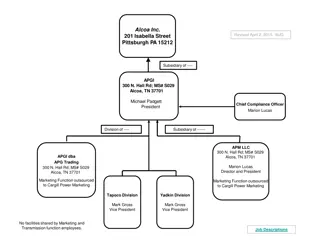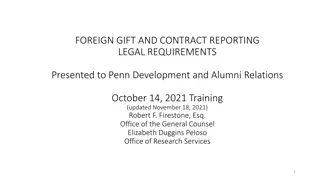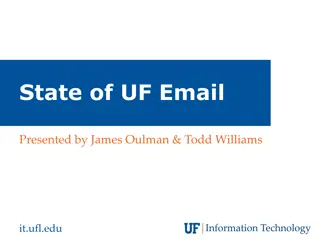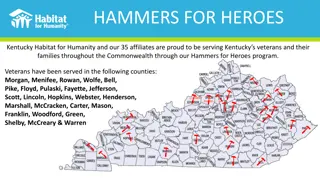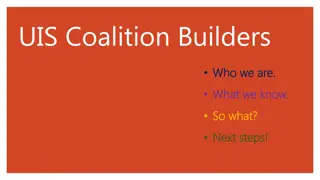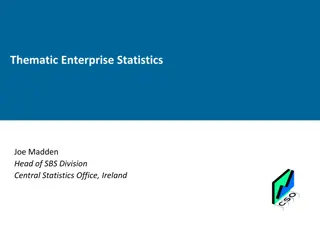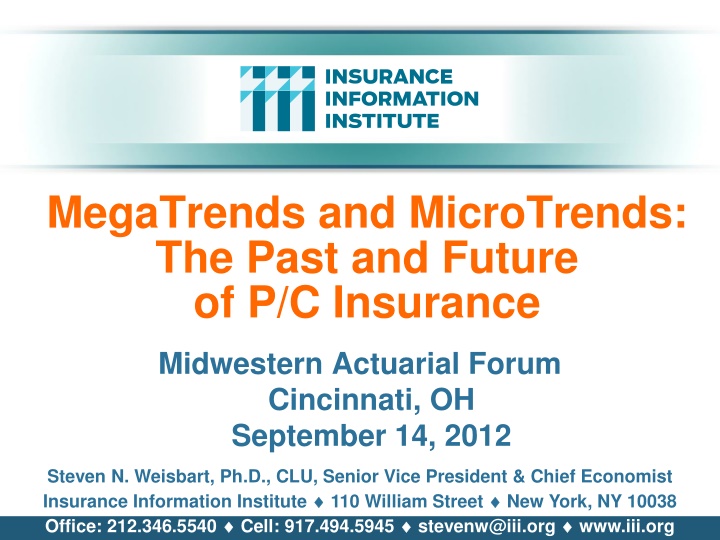
P/C Insurance Industry Trends and Financial Overview
"Explore the past and future trends of the property and casualty (P/C) insurance industry, including insights on net written premiums, underwriting gains/losses, combined ratios, and reserve developments. Discover key data and analysis from industry expert Steven N. Weisbart."
Download Presentation

Please find below an Image/Link to download the presentation.
The content on the website is provided AS IS for your information and personal use only. It may not be sold, licensed, or shared on other websites without obtaining consent from the author. If you encounter any issues during the download, it is possible that the publisher has removed the file from their server.
You are allowed to download the files provided on this website for personal or commercial use, subject to the condition that they are used lawfully. All files are the property of their respective owners.
The content on the website is provided AS IS for your information and personal use only. It may not be sold, licensed, or shared on other websites without obtaining consent from the author.
E N D
Presentation Transcript
MegaTrends and MicroTrends: The Past and Future of P/C Insurance Midwestern Actuarial Forum Cincinnati, OH September 14, 2012 Steven N. Weisbart, Ph.D., CLU, Senior Vice President & Chief Economist Insurance Information Institute 110 William Street New York, NY 10038 Office: 212.346.5540 Cell: 917.494.5945 stevenw@iii.org www.iii.org
P/C Insurance Industry Financial Overview The Long-Term Past and Short-Term Future of the P/C Insurance Industry 2
Net Written Premiums: Soft Market Persisted into 2011 but Growth Returned; More in 2012? 2000-03 25% 1975-78 1984-87 NWP rose 3.3% in 2011; best growth since 2004 2012:Q1 growth: 3.1% 20% 15% 10% 5% 0% -5% 71 72 73 74 75 76 77 78 79 80 81 82 83 84 85 86 87 88 89 90 91 92 93 94 95 96 97 98 99 00 01 02 03 04 05 06 07 08 09 10 11 12 Net Written Premiums fell 0.7% in 2007 (1st year-over-year drop since 1943), fell 2.0% in 2008, and 4.2% in 2009 the first 3-successive-year decline since 1930-33. Shaded areas denote hard market periods Sources: A.M. Best (historical and forecast), ISO, Insurance Information Institute. 3
Underwriting Gain (Loss) 1975 2011* U/W $ Billions losses in 2011 at $36.5B are the largest since 2001 $31.12 $40 $19.02 $30 $20 $1.72 $1.30 $1.11 $10 $0 ($1.30) ($2.19) ($2.98) ($3.33) ($4.23) -$10 ($5.22) ($5.56) ($6.03) ($6.29) ($10.29) ($10.20) ($10.43) ($11.81) ($13.32) -$20 ($16.57) ($17.38) ($17.16) ($17.67) ($18.09) ($20.46) ($20.84) ($21.17) ($21.62) ($21.65) ($22.08) ($24.75) ($25.11) -$30 ($32.14) ($32.35) -$40 ($36.26) ($36.51) -$50 ($52.69) -$60 -$70 75 76 77 78 79 80 81 82 83 84 85 86 87 88 89 90 91 92 93 94 95 96 97 98 99 00 01 02 03 04 05 06 07 08 09 1011* * Includes mortgage and financial guaranty insurers in all years Sources: A.M. Best, ISO; Insurance Information Institute.
P/C Insurance Industry Combined Ratio, 2001 2011* Higher CAT Losses, Shrinking Reserve Releases, Toll of Soft Market Relatively Low CAT Losses, Reserve Releases Heavy Use of Reinsurance Lowered Net Losses As Recently as 2001, Insurers Paid Out Nearly $1.16 for Every $1 in Earned Premiums Relatively Low CAT Losses, Reserve Releases Avg. CAT Losses, More Reserve Releases Best 120 Combined Ratio Since 1949 (87.6) 115.8 Cyclical Deterioration 110 107.5 106.4 101.0 100.9 100.8 100.1 100 99.3 98.4 95.7 92.6 2006 90 2001 2002 2003 2004 2005 2007 2008 2009 2010 2011* * Excludes Mortgage & Financial Guaranty insurers 2008--2011. Including M&FG, 2008=105.1, 2009=100.7, 2010=102.4, 2011=106.4 Sources: A.M. Best, ISO. 5
P/C Reserve Development, 1992 2013F Prior year reserve releases totaled $8.8 billion in the first half of 2010, up from $7.1 billion in the first half of 2009 $30 8 Prior Yr. Reserve Development ($B) Impact on Combined Ratio (Points) 24 $25 Prior Yr. Reserve Release ($B) 6 $20 Impact on Combined Ratio (Points) 15 4 $15 11 11 9 $10 2 $5 2 0 $0 (0) (2) (2) -$5 (3) -2 (4) (5) (5) (7) (7) -$10 (8) (9) (10) (10) -4 (10)(11) -$15 (14) -$20 -6 11E 12F 13F 92 93 94 95 96 97 98 99 00 01 02 03 04 05 06 07 08 09 10 Reserve Releases Remained Strong in 2010 But Tapered Off in 2011. Releases Are Expected to Further Diminish in 2012 and 2103 Note: 2005 reserve development excludes a $6 billion loss portfolio transfer between American Re and Munich Re. Including this transaction, total prior year adverse development in 2005 was $7 billion. The data from 2000 and subsequent years excludes development from financial guaranty and mortgage insurance. Sources: Barclays Capital; A.M. Best. 6
A Hard Market in the Future? Criteria Status Comments Sustained Period of Large Underwriting Losses Overall p/c underwriting losses exceeded $10 billion in 3 of last 4 years Combined ratios rising, masked by reserve releases (110+ at onset of last hard market) Surplus hit a record $565B as of 3/31/11 Analysts est. excess surplus of $75-$100B Some excess capacity may still remain in reinsurance markets Somewhat in Place Not Even Close Material Decline in Surplus/ Capacity Tight Somewhat in Place Reinsurance Market Renewed Underwriting & Pricing Discipline Higher prices in Asia/Pacific Modestly improved pricing for US risks Commercial lines pricing trends now modestly rising Competition remains intense as many seek to maintain market share Terms & conditions no broad tightening Not Broadly Evident Sources: Barclays Capital; Insurance Information Institute. 7
P/C Net Income After Taxes 1991 2011 $Millions P-C Industry 2011 profits were down 46% vs. 2010 to $19.2B, mainly due to high catastrophe losses and deteriorating non-cat underwriting results $80,000 $65,777 2005 ROE*= 9.6% 2006 ROE = 12.7% 2007 ROE = 10.9% 2008 ROE = 0.1% 2009 ROE = 5.0% 2010 ROE = 5.6% 2011:Q3 ROAS1 = 1.9% $62,496 $70,000 $60,000 $44,155 $38,501 $36,819 $50,000 $35,204 $30,773 $30,029 $28,672 $40,000 $24,404 $21,865 $20,598 $20,559 $19,316 $19,150 $30,000 $14,178 $10,870 $20,000 $5,840 $3,046 $3,043 $10,000 $0 -$10,000 -$6,970 91 92 93 94 95 96 97 98 99 00 01 02 03 04 05 06 07 08 09 10 11 * ROE figures are GAAP; 1Return on avg. surplus. Excluding Mortgage & Financial Guaranty insurers yields a 3.0% ROAS for 2011:Q3, 7.5% for 2010 and 7.4% for 2009. Sources: A.M. Best, ISO, Insurance Information Institute 8
Profitability Peaks & Troughs in the P/C Insurance Industry, 1975 2012:Q1* ROE History suggests next ROE peak will be in 2016-2017 25% 1977:19.0% 1987:17.3% 2006:12.7% 20% 1997:11.6% 2012:Q1 8.2% 15% 9 Years 10% 5% 2011: 4.6%* 0% 1975: 2.4% 2001: -1.2% 1992: 4.5% 1984: 1.8% -5% 11* 75 76 77 78 79 80 81 82 83 84 85 86 87 88 89 90 91 92 93 94 95 96 97 98 99 00 01 02 03 04 05 06 07 08 09 10 12: *Profitability = P/C insurer ROEs. 2011 figure is an estimate based on ROAS data. Note: Data for 2008-2012 exclude mortgage and financial guaranty insurers. 2012:Q1 ROAS = 7.2% including M&FG. Sources: Insurance Information Institute; NAIC, ISO, A.M. Best.
Policyholder Surplus, 2006:Q4 2012:Q1 2012:Q1 = new peak 2011:Q1 = previous surplus peak ($ Billions) $625 $564.7 $570.6 $559.1 $600 $556.9 $550.3 $544.8 $540.7 $538.6 $575 $530.5 $521.8 $517.9 $515.6 $512.8 $511.5 $550 $505.0 $496.6 $490.8 $487.1 $525 $478.5 $463.0 $500 $455.6 $437.1 $475 $450 $425 06:Q4 07:Q1 07:Q2 07:Q3 07:Q4 08:Q1 08:Q2 08:Q3 08:Q4 09:Q1 09:Q2 09:Q3 09:Q4 10:Q1 10:Q2 10:Q3 10:Q4 11:Q1 11:Q2 11:Q3 11:Q4 12:Q1 Quarterly Surplus Changes Since 2011:Q1 Peak 11:Q2: -$5.6B (-1.0%) 11:Q3: -$26.1B (-4.6%) 11:Q4: -$14.4B (-2.6%) Note: Beginning in 2010:Q1 figures include $22.5B of paid-in capital from a holding company parent to a subsidiary insurer. It was a single investment in a non-insurance business. Source: ISO; A.M .Best. 10
Economic Drivers of P/C Insurance Exposures Growth in the Wake of the Great Recession 11
The Post-Recession US Economy is Forecast to Keep Growing*, but Slowly Real GDP Growth at Annual Rate(%) We need sustained inflation- adjusted growth rates over 3% to make significant progress toward full employment 5.0% 4.1% 4.0% 4.0% 2.7%2.9% 3.0% 2.6%2.4% 2.5% 2.4% 2.3%2.2% 2.0% 1.5%1.7%1.9%1.8% 2.0% 1.4% 1.3% 1.0% 0.1% 0.0% 09:3Q 09:4Q 10:1Q 10:2Q 10:3Q 10:4Q 11:1Q 11:2Q 11:3Q 11:4Q 12:1Q 12:2Q 12:3Q 12:4Q 13:1Q 13:2Q 13:3Q 13:4Q Some economists worry that as of Jan 1, 2013, planned federal spending cuts, the expiration of income tax rate reductions, and the end of some unemployment benefits will sap growth and could trigger another recession in 2013. * Sources: US Department of Commerce, http://www.bea.gov/newsreleases/national/gdp/gdpnewsrelease.htm ; Blue Chip Economic Indicators 8/2012 issue (forecasts); Insurance Information Institute. Forecasts from Blue Chip Economic Indicators 12
Construction of Private Housing Is Picking Up Housing Starts, Millions of Units Forecast range for 2013: 730,000 to 1,200,000 Forecast range for 2012: 660,000 to 800,000 2.07 2.1 1.96 1.85 1.80 1.8 1.71 1.621.641.571.60 1.46 1.481.47 1.5 1.35 1.36 1.29 1.19 1.20 1.2 1.01 0.90 0.89 0.9 0.75 0.550.590.61 0.6 0.3 0.0 12F 13F 90 91 92 93 94 95 96 97 98 99 00 01 02 03 04 05 06 07 08 09 10 11 Weak home construction forecast implies little exposure growth likely for Homeowners insurers and insurers with a residential construction book of business for the next few years. Sources: U.S. Census Bureau and Department of Housing and Urban Development (history) at http://www.census.gov/const/newresconst.pdf ; Blue Chip Economic Indicators (8/2012), forecasts; Insurance Information Institute. 13
But the Pickup is Mostly in Multi-Family Housing Starts Thousands of Units, Single Family units in multi-family buildings single family units Thousands of Units, Multi-Family 400 1800 Multi-family-unit starts rose in 2011, and more in 2012. 1600 350 1400 300 1200 Single family plunge began in 2006 250 1000 200 800 Multi-family plunge didn t begin until 2009 150 600 100 400 2001 2002 2003 2004 2005 2006 2007 2008 2009 2010 2011 2012* Multi-unit starts, currently at a seasonally-adjusted annual rate of 215,000, are double the 2009 rate. Average annual rate for 2001-2006: 339,000. *January-July 2012 data, annualized, seasonally-adjusted, preliminary (July) Source: US Census Bureau at http://www.census.gov/construction/nrc/pdf/newresconst.pdf
The Auto Insurance Picture A New Normal : More Old Cars on the Road 15
The Car-Buying Slump Is Creating Pressure to Replace Aging Vehicles 2011 AAA Survey: 1 in 4 drivers have neglected repairs and maintenance because of the economy (Millions of Units) Forecast range for 2013: 13.7 to 16.7 19 17.8 17.5 17.4 17.1 Forecast range for 2012: 13.7 to 15.1 16.9 18 16.9 16.6 16.5 16.1 17 16 14.8 14.4 15 13.2 14 12.7 13 11.6 12 10.4 11 10 9 99 00 01 02 03 04 05 06 07 08 09 10 11 12F 13F Many more older cars are on the road today than In normal times. Previously in a 3-year span, new cars would replace about 35 million old cars, but in 2008-10 only about 27 million old cars were replaced. Sources: history--U.S. Department of Commerce; forecasts (including 2011 preliminary--Blue Chip Economic Indicators (7/2012); Insurance Information Institute; USA Today 8/10/2011 edition (AAA Survey). 16
But People Are Not Driving More: Miles Driven*, 1990 2012 Billions 3,100 Growth per Decade 1999 vs. 1989: 27.2% 2009 vs. 1999: 9.4% 3,000 2,900 Some of the prior growth in miles driven is due to population growth: 1999 vs. 1989: 10.5% 2009 vs. 1999: 12.6% 2,800 A record: miles driven has been below the prior peak for 52 straight months. Previous record was in the early 1980s (39 months) 2,700 2,600 2,500 2,400 Will the trend toward hybrid and non-gasoline- powered vehicles affect miles driven? What about the aging and retirement of the baby boomers? 2,300 2,200 2,100 '90 '91 '92 '93 '94 '95 '96 '97 '98 '99 '00 '01 '02 '03 '04 '05 '06 '07 '08 '09 '10 '11 '12 *Moving 12-month total. The latest data is for June 2012. Note: Recessions indicated by gray shaded columns.. Sources: Federal Highway Administration (http://www.fhwa.dot.gov/ohim/tvtw/tvtpage.cfm ); National Bureau of Economic Research (recession dates); Insurance Information Institute. 17
Do Changes in Miles Driven Affect Auto Collision Claim Frequency? Paid Claim Frequency = (# of paid claims)/(Earned Car Years) x 100 Collision Claim Frequency Billions of Vehicle Miles 7.0 3050 6.91 3000 6.65 Paid Claim Freq Billions of Miles Driven 6.5 2950 6.32 2900 6.02 The frequency drop is slowing 5.94 6.0 2850 5.85 5.71 5.70 2800 5.66 5.62 5.60 5.5 2750 2001 2002 2003 2004 2005 2006 2007 2008 2009 2010 2011 Pay-As-You-Go Auto Insurance: Fluctuations in miles driven will affect exposure Sources: Federal Highway Administration (http://www.fhwa.dot.gov/ohim/tvtw/tvtpage.cfm; ISO Fast Track Monitoring System, Private Passenger Automobile Fast Track Data: 4th Qtr. 2011, published April 5, 2012, and earlier reports.
The Commercial Insurance Picture The Near-Term Outlook for Small Business is Getting Better but isn t Bright 19
Recovery in Capacity Utilization is a Positive Sign for Commercial Exposures March 2001 through July 2012 Full Capacity Percent of Industrial Capacity The US operated at 79.3% of industrial capacity in May 2012, above the June 2009 low of 68.3% and close to its post-crisis peak 82% Hurricane Katrina 80% 78% 76% The closer the economy is to operating at full capacity, the greater the inflationary pressure 74% 72% 70% March 2001- November 2001 recession 68% December 2007- June 2009 Recession 66% Mar 01 Mar 02 Mar 03 Mar 04 Mar 05 Mar 06 Mar 07 Mar 08 Mar 09 Mar 10 Mar 11 Mar 12 Sep Sep Sep Sep Sep Sep Sep Sep Sep Sep Sep Source: Federal Reserve Board statistical releases at http://www.federalreserve.gov/releases/g17/Current/default.htm. 20 20
Business Bankruptcy Filings: Falling but Still High in 2012 (1994:Q1 2012:Q1) (Thousands) New Bankruptcy Law Takes Effect 18 11.512.914.316.0 15.0 16 14.6 14.5 14.2 14.0 14.0 14.0 13.9 13.8 13.6 13.5 13.4 13.2 12.013.1 13.0 14 12.9 12.9 12.9 12.8 12.6 12.7 Recessions in orange 12.4 12.4 12.3 12.2 11.7 11.6 11.1 11.0 12 10.6 10.3 9.210.4 10.3 10.0 10.0 9.9 9.8 7.28.08.79.7 9.7 9.5 9.5 8.79.5 9.5 9.4 9.3 10 9.2 9.0 9.0 8.8 8.4 8.4 8.3 8.2 8.2 8.1 7.8 7.6 8 6.7 5.66.3 6 5.3 4.14.9 4 2 0 94:Q1 Business bankruptcies were down 46.5% in 2012:Q1 vs. recent peak in 2009:Q2 but were still higher than 2008:Q2, early in the Great Recession. Bankruptcies restrict exposure growth in all commercial lines. Sources: American Bankruptcy Institute at http://www.abiworld.org/AM/AMTemplate.cfm?Section=Home&TEMPLATE=/CM/ContentDisplay.cfm&CONTENTID=61633 ; Insurance Information Institute 94:Q3 95:Q1 95:Q3 96:Q1 96:Q3 97:Q1 97:Q3 98:Q1 98:Q3 99:Q1 99:Q3 00:Q1 00:Q3 01:Q1 01:Q3 02:Q1 02:Q3 03:Q1 03:Q3 04:Q1 04:Q3 05:Q1 05:Q3 06:Q1 06:Q3 07:Q1 07:Q3 08:Q1 08:Q3 09:Q1 09:Q3 10:Q1 10:Q3 11:Q1 11:Q3 12:Q1 21
Private Sector Business Starts, 1993:Q2 2011:Q4* Business Starts 2006: 872,000 2007: 843,000 2008: 790,000 2009: 697,000 2010: 722,000 2011: 758,000 (Thousands) Recessions in orange 230 209216221 221 221 221 220 220 216 214 205212 211 210 210 203209 204208 208 193200207 207 210 206 206 206 206 206 206 200205 199204 204 204 203 202 201 201 200 200 199 192198 183187191197 200 196 196 195 186190194 194 193 174180186192 191 191 191 189 188 188 188 187 186 190 182 175179 172177 180 175 169 170 160 150 93 94 95 96 97 98 99 00 01 02 03 04 05 06 07 08 09 10 11 Business starts were down nearly 20% in the Great Recession, holding back most types of commercial insurance exposure, but now are recovering. * Data through Dec 31, 2011 are the latest available as of August 2, 2012; Seasonally adjusted. Sources: Bureau of Labor Statistics, http://www.bls.gov/news.release/cewbd.t08.htm. NBER (recession dates) 22 22
Catastrophe Loss Developments and Trends 2011 Rewrote Catastrophe Loss and Insurance History 23
Number of Federal Major Disaster Declarations, Yearly, 1953-2012* The average number from 1996- 2010 was 58.4. 99 100 90 From 1953-71, the average number of declarations per year was 16.5. 81 The average number from 1972-1995 was 31.7. 80 75 75 69 70 65 63 59 60 56 4852 50 4549 48 50 46 46 45 45 44 43 42 42 38 38 40 3236 34 32 31 30 29 28 27 30 2025 25 25 24 23 23 22 22 21 19 18 1317 17 17 20 The number of federal disaster declarations set a new record in 2011. 16 16 15 12 12 11 11 11 10 7 7 0 53 55 57 59 61 63 65 67 69 71 73 75 77 79 81 83 85 87 89 91 93 95 97 99 01 03 05 07 09 11 Of the 42 federal major disaster declarations in 2012 so far, 23 were for wildfires, 16 were windstorms, 2 winter storms, 1 tropical storm. *Through July 27, 2012. Sources: Federal Emergency Management Administration at http://www.fema.gov/disasters?field_state_tid=All&field_disaster_type_term_tid=All&field_disaster_declaration_type _value=All&items_per_page=60&=GO ; Insurance Information Institute.
US Insured Catastrophe Losses, Yearly, 1989-2011* $ Billions of 2011 dollars CAT Losses Surged on Record Tornado Activity $90 $71.7 $80 2000s: A Decade of Disaster 2001-2010: $202B (up 122%) 1991-2000: $91B $70 $60 $50 $36.9 $33.9 $32.9 $32.3 $28.5 $40 $25.8 $30 $15.9 $14.3 $14.0 $13.7 $12.3 $11.3 $11.2 $10.7 $10.3 $20 $8.6 $7.8 $7.4 $7.3 $6.0 $4.7 $3.7 $10 $0 89 90 91 92 93 94 95 96 97 98 99 00 01 02 03 04 05 06 07 08 09 10 11* US insured CAT losses do not include amounts paid by the National Flood Insurance Program. *ISO estimate. Note: 2001 figure includes $20.3B for 9/11 losses reported through 12/31/01 ($25.9B 2011 dollars). Includes only business and personal property claims, business interruption and auto claims. Non-prop/BI losses = $12.2B ($15.6B in 2011 dollars.) Sources: Property Claims Service/ISO; Insurance Information Institute. 25
Inflation & Price Drivers of P/C Insurance Claims P-C Claim Severity Generally Has Risen Faster than the CPI 26
The Bond Markets Recent* Expectation of U.S. Inflation in the Next Two Years In early 2011, the bond market thought near- term inflation would rise above 2%. But by Summer 2011 the bond market thought near-term inflation was likely to fall below 1.5%. 3.0% 2.5% 2.0% 1.5% 1.0% Lately the bond market expects inflation over the next two years near 1.5% per year. 0.5% 0.0% 08/16/10 09/15/10 10/15/10 11/14/10 12/14/10 01/13/11 02/12/11 03/14/11 04/13/11 05/13/11 06/12/11 07/12/11 08/11/11 09/10/11 10/10/11 11/09/11 12/09/11 01/08/12 02/07/12 03/08/12 04/07/12 05/07/12 06/06/12 07/06/12 08/05/12 09/04/12 The rate is calculated by subtracting the real yield of the 2-year TIPS bond from the yield of the 2-year Treasury note. The result is the implied inflation rate for the next 2 years. *Daily, from 8/17/2010 through 7/30/2012 Source: http://www.bloomberg.com/apps/quote?ticker=USGGBE02:IND 27
Auto Liability Claims Severity Trends, 2005-2010 Change from prior year BI Severity PD Severity PIP Severity 7% 6.5% 6.0% 6.5% 6.1% 6.2% 6% 5.4% 5% 4.7% 4.7% 4% 3.6% 3.3% 3% 2.9% 2.9% 2.4% 2.2% 2.1% 2% 1.9% 1% 0.8% 0% -0.3% -1% 2005 2006 2007 2008 2009 2010 The average severity of auto property damage liability claims has grown slightly more slowly than overall inflation. Beginning in 2006, average severity for BI and PIP grew much faster. Sources: ISO/PCI Fast Track data; Bureau of Labor Statistics (CPI); Insurance Information Institute 28
P/C Insurance Claim Cost Drivers Grow Faster than even the Medical CPI Suggests Mar 2012 Y-o-Y Price Changes 6% 5.3% Excludes Food and Energy 4.9% 4% 4.2% 3.5% 3.3% 2.7% 2% 2.3% 1.3% 0% Overall CPI "Core" CPI Medical CPI Inpatient Hospital Services Outpatient Hospital Services Physicians' Services Prescription Drugs Medical Care Commodities Healthcare costs are a major liability, med pay, and PIP claim cost driver. They are likely to grow faster than the CPI for the next few years, at least Source: Bureau of Labor Statistics; Insurance Information Institute. 29
P/C Commercial Property Insurance Claim Cost Drivers Grow Faster than the Overall CPI Suggests Price Level Change: 2011 vs. 2010 9% 8.7% 7.6% 7% Excludes Food and Energy 5% 3.9% 3.9% 3.8% 3% 2.7% 2.7% 2.3% 1% Overall CPI "Core" CPI Inputs to Construction Industries Non-residential maintenance & repair Asphalt Paving & Roofing Materials HVAC & Commercial refrigeration Plumbing Fixtures & Fittings Paint, coating & adhesive mfg. Copper prices spiked and retreated in 2011. In July its price was 33% higher than a year earlier; by November it cost 8% less than in November 2010. Sources: Bureau of Labor Statistics; Insurance Information Institute. 30 30
Whats a MegaTrend? What s a MicroTrend? Looking beyond day-to-day developments What are the implications for Insurance and Risk Management? 31
A MegaTrend is Something Generally changing the way things get done Happening on an enormous scale Growing rapidly 32
Books and Websites Proclaim Various MegaTrends 33
3 MegaTrends to Watch There are many proclaimed MegaTrends. These three come from Forbes.com http://www.forbes.com/sites/haydnshaughnessy/2011/12/28/3-megatrends-for- 2012-or-why-shared-value-is-indeed-an-answer/ 34
1. The Global Growth and Transformation of the Middle Class A huge market for personal insurance (possibly 1 billion people) is emerging in developing countries At the same time, the middle class in advanced economies is shrinking Selling insurance to the new global middle class will require teaching whole populations what insurance is, how it works, and why one would choose one brand over another 35
Non-life Premium* per capita (Density) for Selected Economies, 2010 $2,400 Imagine the amount of P/C premium that would be generated if the density in China or India matched the current density in the major European countries $2,127 $1,887 $2,000 $1,502 $1,600 $1,311 $1,249 $1,200 $1,060 $917 $800 $290 $400 $200 $158 $53 $9 $0 U.S. Canada Germany Australia France U.K. Japan Russia South Africa Brazil China India From 2002-2010, Insurance Density in India tripled, and in China it grew 5-fold. But the most spectacular Density growth in these years belongs to Russia: in 2010 Insurance Density in Russia was 7 times what it was in 2002! * premiums measured in U.S. dollars, exclude cross-border business Source: Swiss Re Sigma, various volumes
2. The Growth of a More Individualistic Capitalism Mass marketing is giving way to Online services retailers and special-interest community/peer sites are giving customers/ users more control, making the shopping/info- gathering experience more personalized The younger generations are leading the way to managing their lives as unique individuals, sharing with friends/peers but not strangers Implications for P/C insurance Follow the microtrends? 37
3. The Rise of the New Business Ecosystem The new ecosystem is technology-enabled and works with potentially hundreds of sub- vendors the Apple App store or Itunes Amazon marketplace It marries small-firm innovation with large-firm financial muscle Implications for P/C insurance? A radically different distribution system? Will Amazon.com develop a virtual Lloyd s ? A radically different claims apparatus? 38
An Insightful Book Published About 5 Years Ago 39
A MicroTrend is An intense identity group, growing rapidly With needs and wants unmet by the current crop of companies, policymakers, and others who would influence society s behavior Typical size: 1% of the population 40
7 MicroTrends to Watch There s More: Mark Penn s book cites 68 other MicroTrends 41
1. Sex-Ratio Singles (Single Women) For the first time in America, there are more single women than ever who are likely to stay that way. From shortly after birth, women outnumber men, and men are more likely to be homosexual than women are In 2005, single women were the 2nd largest group of home buyers, just behind married couples. They bought 1.5 million homes, more than twice as many as single men. The number of single women bearing/adopting children in 2005 tripled since the early 1990s 42
2. Commuter Couples Dual-career couples who maintain two households In 1990: 1.7 million people In 2005: 3.5 million All ages the number of married people over 50 who live separately tripled between 2001 and 2005 43
3. 30-Winkers The number of people who sleep fewer than 6 hours/night is rising fast 1998: 12% 2005: 16% (34 million people) In the 2005 Sleep in America poll, 37% said they ve nodded off or fallen asleep while driving Less sleep leads to Less productivity Increased obesity New businesses to help people get more sleep Should sleep be an underwriting factor? 44
4. Hard-of-Hearers Roughly 1/3 of people over 65 (about 35 million) are hard-of-hearing But many with hearing loss are under 65 Hearing loss varies by race, geography, gender Occupational/Business Impact: Overcoming hearing loss will be a hot industry in the next few decades New technology (who will lead this? Apple? Bose? Sony? Ford? New entrepreneurs?) Public policy/Insurance impact An anti-noise campaign similar to anti-smoking? Do the hard-of-hearing cause more accidents? 45
5. Old New Dads Births to men aged 50 or older In 1980: 1 in 23 In 2002: 1 in 18 Births to men age 40-44: up 32% Births to men age 45-49: up 21% Old dads will likely Work longer Retire later Drive at older ages 46
6. Newly Released Ex-Cons 650,000 people (90% men, avg. age 34) released from prison of jail each year These people generally have little connection with economic society: Little education Few job prospects Many employers won t hire them Likely results: Increasing crime Worsening public cost of family support financial safety net Are these people insurable in the voluntary market? 47
7. High School Moguls A dozen years ago 8% of all teens (1.6 million) were making money on the internet The top 100 entrepreneurs aged 8-18 in 2001 earned total profits of $7 million In 2006 the U.S. Small Business Administration launched Mind Your Own Business, an online resource to help teenagers develop their start-ups How much do teen business owners know about insurance? How well are we reaching them? 48
Insurance Information Institute Online: www.iii.org Thank you for your time and your attention!










